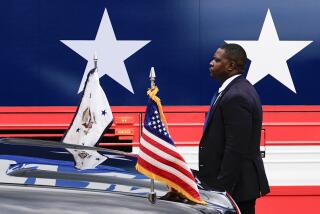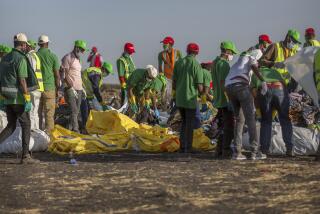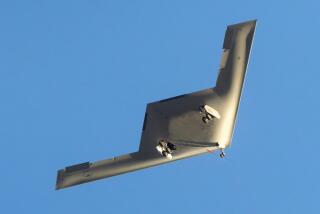Congressman Estimates Figure at Nearly $600 Million Each : Synar Puts Stealth Bomber’s Cost at Twice B-1’s
WASHINGTON — Super-secret Stealth bombers are going to cost nearly $600 million each--more than twice the cost of the B-1 bomber and substantially higher than Pentagon estimates, Rep. Mike Synar (D-Okla.) predicted Wednesday.
Synar is the first member of Congress to publicly discuss the costs of Stealth, which are held as classified information by the Pentagon. Although he has been privy to some classified information about Stealth, he insisted that he was not disclosing any secrets--only clarifying the recent public statements of Pentagon officials.
By publicly estimating the cost of Stealth, Synar appeared to be firing the opening shot in a battle to be waged by a vocal faction in the House and Senate to win congressional approval of a plan to slow down development of the Stealth while purchasing more than 100 B-1 bombers in the interim.
Avoids Detection by Radar
The Pentagon is seeking congressional approval for initial production funds in fiscal 1987 for Stealth, officially known as the Advanced Technical Bomber. The aircraft, to be produced by Northrop Corp., is designed to penetrate enemy airspace without being detected by radar. Its development was first disclosed in August, 1980, by President Jimmy Carter.
Faced with growing congressional debate over the unknown cost of Stealth, Donald A. Hicks, undersecretary of defense for research and engineering, recently estimated that it would be no more than 2% to 3% above the cost of the B-1 bomber, which is estimated by the Pentagon at $270 million each.
But Synar accused Hicks of “serious misrepresentation” of the cost of Stealth. “I hate to suggest that the undersecretary is engaging in political gamesmanship, but it appears he may be using the cloak of national security to shield the Stealth from public debate on the cost,” he said.
Cost Artificially Low
According to Synar, Hicks’ estimate is artificially low because it was based on 1981 dollars.
“If one converts the number which the undersecretary has publicly disclosed to real dollars--that is, how much will the Stealth cost when we buy it?--the picture changes dramatically,” he said. “The true cost of Stealth becomes $75 to $80 billion, or nearly $600 million a copy.”
He also estimated that Stealth will absorb $16 billion of the total Air Force procurement budget of $19 billion in fiscal 1987--or about $5 of every $6 spent.
Other members of Congress refused to comment directly on Synar’s estimate on grounds that the information is classified. But Sen. Sam Nunn (D-Ga.), ranking Democrat on the Senate Armed Services Committee and a Stealth proponent, remarked that many of the charges leveled at the super-secret bomber have been “inaccurate.”
Rep. David McCurdy (D-Okla.), a member of the House Armed Services Committee and another Stealth proponent, suggested that Synar’s estimate was somewhat inflated. “You have to compare apples and apples, and he’s not doing that,” McCurdy said.
At the same time, an aide of Synar said the estimate was consistent with the classified material supplied to Synar last month under legislation he authored.
As for Hicks, the undersecretary, he was said by a Pentagon spokesman to be ill and unavailable for comment.
Hicks originally made his estimate in remarks to a defense industry group in California and repeated them on Feb. 18 to a House Armed Services subcommittee. He did not disclose publicly how he arrived at his comparison between Stealth and B-1 costs.
A knowledgeable source, speaking on the condition that he not be further identified, said that in figuring his estimate Hicks may have boosted the cost of the B-1 by adding a variety of things including $5.5 billion spent for initial research. By some estimates, the B-1 bomber could end up costing $400 million per plane when all developmental costs are included.
In hearings and private briefings, Air Force officials have made a concerted effort recently to calm members of Congress who are concerned about the Stealth bomber’s weight and payload capabilities as well as its enormous cost.
One Defense Department source noted that opponents of the weapon have an advantage because the Pentagon responds to inaccurate charges with accurate information. “The opponents are getting in free shots,” he said.
Nunn said he believes the Pentagon will soon respond to this pressure by declassifying some information about Stealth, including its cost.
Other congressional sources said the Air Force has recommended making some information about Stealth available to the public, but Defense Secretary Caspar W. Weinberger has opposed it on grounds that it would enable the Soviets to more accurately assess the capabilities of the secret aircraft. “We just aren’t going public on any details about the ATB project,” one Pentagon official said.
Synar said he intends to propose legislation in the near future that will place a cap on Stealth expenditures and require testing of the aircraft before Congress provides funds for production. He predicted that his proposal would gain widespread support.
Although Synar represents a district that includes employees of Rockwell Corp. involved in production of the B-1 bomber, he denied that his opposition to Stealth is designed to win further production funds for the B-1. Last year, Congress appropriated $5.6 billion to purchase the final 48 B-1s to be produced--bringing the total number of aircraft purchased to 100.
“My opponents believe I’m touting B-1, but that is not true,” Synar said. “I think that the most expensive weapons system in history deserves more scrutiny--whether the costs are justified and whether it will fly.”
But Synar’s efforts clearly aided many other members of Congress, including such Californians as Reps. Duncan L. Hunter (R-Coronado) and Robert K. Dornan (R-Garden Grove), who are seeking production of additional B-1 bombers while Congress debates the rising cost of Stealth. Hunter, for example, will propose the expenditure of $200 million to keep the B-1 production line open without actually producing additional aircraft.
Seven contractors bid to build new fighter jet. Part IV, Page 2.
More to Read
Inside the business of entertainment
The Wide Shot brings you news, analysis and insights on everything from streaming wars to production — and what it all means for the future.
You may occasionally receive promotional content from the Los Angeles Times.










